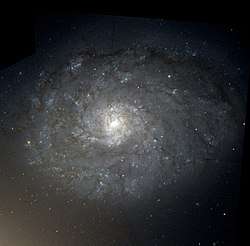NGC 4647
NGC 4647 is a spiral galaxy estimated to be around 63 million light-years away[2] in the constellation of Virgo.[3] It was discovered by astronomer William Herschel on March 15, 1784.[3] NGC 4647 is listed along with Messier 60 as being part of a pair of galaxies called Arp 116;[4][5] their designation in Halton Arp's Atlas of Peculiar Galaxies. The galaxy is located on the outskirts of the Virgo Cluster.[6]
| NGC 4647 | |
|---|---|
 Hubble image of the galaxy NGC 4647. | |
| Observation data (J2000 epoch) | |
| Constellation | Virgo |
| Right ascension | 12h 43m 32.3s[1] |
| Declination | 11° 34′ 55″[1] |
| Redshift | 0.004700/1409 km/s[1] |
| Distance | 63 Mly (estimated) |
| Group or cluster | Virgo Cluster |
| Apparent magnitude (V) | 11.94[1] |
| Characteristics | |
| Type | SAB(rs)c[1] |
| Size | ~90,000 ly (estimated) |
| Apparent size (V) | 2.9 x 2.3[1] |
| Other designations | |
| Arp 116, CGCG 71-15, IRAS 12410+1151, KCPG 353A, MCG 2-33-1, PGC 42816, UGC 7896, V V 206, VCC 1972[1] | |
Interaction with Messier 60
In optical images, the two galaxies disks overlap. This has suggested an ongoing interaction, however images do not reveal any signs of star formation which would have been caused by a tidal interaction between the two galaxies. Recent studies of Hubble images made in 2012 of the two galaxies indicate that tidal interactions between the two have just begun.[7]
Interstellar medium of NGC 4647
The gas in NGC 4647 has been mildly disturbed. The galaxy's location in the Virgo Cluster suggests that might it suffered an effect known as ram-pressure stripping caused by the intracluster medium. Another explanation may be hot gas in the halo of Messier 60. The hot gas in Messier 60 may have increased the pressure of gas on the eastern side of NGC 4647 through either ram-pressure striping or a bow-shock between the two galaxies causing the observed asymmetry of gas in the galaxy. The difficulty is that the galaxies would have to be so close that tidal forces from Messier 60 would cause the disk of NGC 4647 to get ripped apart.[8]
SN1979A
On January 25, 1979 a Type-1 supernova was discovered in NGC 4647.[9][10]
See also
References
- "NASA/IPAC Extragalactic Database". Results for NGC 4647. Retrieved 2017-09-02.
- "APOD: 2016 January 28 - Elliptical M60, Spiral NGC 4647". apod.nasa.gov. Retrieved 2017-09-03.
- "New General Catalog Objects: NGC 4600 - 4649". cseligman.com. Retrieved 2017-09-03.
- "NASA - Odd Galaxy Couple on Space Voyage". www.nasa.gov. Retrieved 2017-09-03.
- "Your NED Search Results". ned.ipac.caltech.edu. Retrieved 2017-09-03.
- Cullen, Harriet; Alexander, Paul; Green, D.; Sheth, K. (November 2004). "Neutral ISM in the Interacting Spiral NGC 4647". ASP Conference Series. 320: 156–157. Bibcode:2004ASPC..320..156C.
- "Hubble Heritage". heritage.stsci.edu. Retrieved 2017-09-03.
- Young, L. M.; Rosolowsky, E.; Gorkom, J. H. Van; Lamb, S. A. Lamb (15 June 2006). "THE EVOLUTION OF THE INTERSTELLAR MEDIUM IN THE MILDLY DISTURBED SPIRAL GALAXY NGC 4647". The Astrophysical Journal. 650 (1): 166–179. arXiv:astro-ph/0606410. Bibcode:2006ApJ...650..166Y. doi:10.1086/506959.
- "1979A | Transient Name Server". wis-tns.weizmann.ac.il. Retrieved 2017-09-03.
- Randall, Scott W.; Sarazin, Craig L.; Irwin, Jimmy A. (5 September 2005). "XMM-NEWTON OBSERVATION OF DIFFUSE GAS AND LOW-MASS X-RAY BINARIES IN THE ELLIPTICAL GALAXY NGC 4649 (M60)". The Astrophysical Journal. 636: 200–213. doi:10.1086/497977.
External links
| Wikimedia Commons has media related to NGC 4647. |
- NGC 4647 on WikiSky: DSS2, SDSS, GALEX, IRAS, Hydrogen α, X-Ray, Astrophoto, Sky Map, Articles and images